Traps for Biting Flies
Deer flies, horse flies, sand flies, face flies and horn flies are very irritaiting to animals and people, but are not attracted to the traps that catch house fly and other filth breeding flies. Commercially available fly parasites don't attack the pupal stages of these flies. To deal with them you need biting fly traps. Studies have shown that 5 biting flies per leg or 10 tail twitches per minute is the economic injury level for treating for biting flies. Here are some options for simple mechanical traps.
Olson sticky traps
Farnam Bite-Free
Epps biting fly trap
Nzi biting fly trap
Horse Pal biting fly trap
Other devices
DIY traps
Biocontrols
Olson Sticky Traps for Biting Flies
STICKY YELLOW BANNER (STBN2Y) 2 inch wide by 530 ft sticky yellow plastic for mass trapping in greenhouses or outside.
STICKY ROLL DISPENSER (STDISP-BN2) dispenser for 2 inch wide by 530 feet sticky roll.
STICKY FLY RIBBON (STRIBBON) 1/8 inch wide by 1000 ft. polypropylene banding coated with sticky insect trapping adhesive. 24-hour fly control without toxic sprays. Eliminates time required to hang hundreds of old-fashioned fly ribbons. (SFR 1000)
STICKY FLY RIBBON DISPENSER (STDISP-RIB) Sticky Fly Ribbon dispenser kit for 1/8 in X 1K ft
FACE FLY TRAP (STFF) Alsynite cylinder is covered with a disposable sticky white sleeve which attracts Face Flies. The trap is fastened to an electric fence post (stake not included) that is pushed into the ground at a 45 degree angle. Face Flies think it is a face to go to. White replacement sleeves available in packs of ten. (STRS10-W)
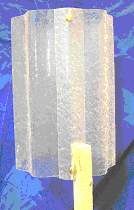 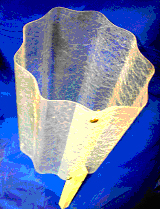
Cylinder for use with sleeves for biting or face flies.
BITING FLY TRAP (STBF) Alsynite cylinder is covered with a disposable sticky clear sleeve which attracts Face Flies. Clear replacement sleeves available in packs of ten. (STRS10-C)
Farnam Bite Free Stable Fly Trap
- No insecticides
- Easy and economical to use – holds more than other sticky traps
- Disposable –when full, just throw away
- Weatherproof – special adhesive won’t melt or wash away
- Compact size – offers a 350° trapping surface that holds 8,000 flies
- Ideal for use around stables, cattle ranches, poultry operations, kennels, restaurants, home and garden
|
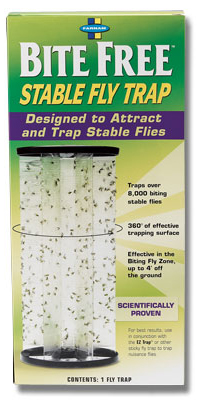 |
Uniquely shaped Bite Free Stable Fly Trap provides an ecomonical solution to those persistent and potentially harmful Stable Flies.
Also known as Dog Flies, these pesky flies attack horses, livestock, dogs, and humans, leaving you and your animals prone to secondary infections, disease transmittance, and persistent stomping and scratching.
Stable Flies bite humans and livestock on the legs, and dogs and cats on the ears. Bite Free Stable Fly Trap provides relief from these pests in an easy to set up, insecticide and odor free, disposable trap.
Simply place trap at least 10 feet away from barns, houses, gardens, and kennels.
Epps Biting Fly Trap
Significantly Reduces Biting Flies To Help Protect Your Horses
from Equine Infectious Anemia and other Biting-Fly Transmitted Diseases
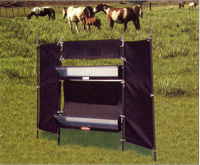
The Epps Biting Fly Trap is a revolutionary concept in fly control. It's designed to fool horse flies, deer flies, stable flies and other biting flies into believing it's an animal. Flies habitually circle an animal before they land to feed, but as they try to fly over or under the 'animal' - they hit the clear plastic 'deflectors' and bounce into the trough of water below and drown. One trap will provide effective control over an area covering up to 40 acres.
Significantly reduces biting flies to help protect your horses from EIA and other biting-fly transmitted diseases. Uses no pesticides, only soapy water. A little dish washing soap reduces the surface tension of the water - making the water wetter, so that the fly sinks and quickly drowns.
What Kind Of Flies Does It Catch? The Epps Trap catches horse flies (green heads, bull flies, yellow fly), deer flies (May flies), the stable fly (Stomoxys calcitrans), and lesser numbers of many other insects, including some mosquito species. It is not an effective trap for non-biting flies such as house flies, blow flies, face flies, or eye gnats.
Where Do The Flies Come From? Horse Flies and deer flies breed in marshy habitats, around pond, streams, and wet spots in pastures. The larvae (maggots) prey on other insects in wet ground. They do not breed in manure, so they are nearly impossible to control as larvae.
Why Control Biting Flies? A silly question to anyone who has been bitten by flies, or who have pets or livestock bothered by biting flies. But what you may not know is that biting flies also transmit serious diseases that can kill or debilitate your animals. FIA (Equine Infectious Anemia) is most often transmitted by horse fly bites. And biting flies are also important transmitters of anaplasmosis in cattle, and can transmit tularemia, anthrax, bovine leukemia virus, California equine encephalitis, hog cholera, various helminthes (worms), and other diseases.
How Does The Trap Work? - Biting lies such as the stable fly, horse flies, green heads, deer flies, bull flies, and the yellow fly tend to circle their host before actually landing to bite. The Epps Trap takes advantage of these behaviors by providing a large contrasting dark area the size of a biting fly's host animal, with clear areas (the deflectors) representing air space between the animal's legs and over its back through which the flies would normally circle before feeding. Flies do not see the clear deflectors as barriers so they try to fly through them, ricocheting into soapy water in the trays
What Kills The Flies? The Epps Trap contains no pesticides. The trays are filled with water mixed with a little dish soap; the soap lowers the water's surface tension and causes the flies to be wetted quickly and drown faster. Even if a horse fly escapes the soapy water surface, it will die soon because of the soap's action.
Why Is The Trap So Big? Day flying biting flies such as horse, deer, and stable flies are attracted to large, dark objects in pastures, because those objects are nearly always potential hosts such as cattle, deer and horses. The size and shape of the Epps Trap fools the flies into thinking it is a potential host. In fact, horse flies that land on the targets may actually try to bite the black fabric before again taking flight and being caught.
Why Are There Two Trays? Some species of biting flies bite on the withers or back, some bite on the legs or belly of their host animal. The species that bite on the belly or legs are trapped in the lower tray, the species that bite on the back are trapped in the upper tray.
How Many Traps Do I Need? In individual pastures smaller than 40 acres, one trap is usually sufficient. Where severe horse fly problems exist, additional traps can be used. In larger pastures use approximately one trap for every 40 acres.
Why Are The End Panels (Targets) Set At 45º To The Trays? The "Z" arrangement of the trap gives it a three dimensional, animal-like appearance to the flies no matter from which direction they approach it. It also aids in funneling flies into the clear deflectors so they ricochet into the soapy water in the trays and are trapped. If the end panels are not set at an angle, flies tend to fly over or around the trap instead of into the deflectors.
Where Should I Put The Trap? The Epps Trap can be used in pastures, around stables, kennels, swimming pools, backyards, beaches and parks. In general, the traps should be set up in an open, sunlit area where flies can easily see the trap. Avoid dense vegetation and heavy woods. If you need to control flies in a wooded area (for example along trails in wooded parks), place the trap in an open area without heavy undergrowth.
Epps Biting Fly Trap Horse and deer flies use trees and bushes for resting sites, and tend to fly along the edges of woods. Placing the trap in the middle of narrowed areas of pastures will catch flies flying across those "shortcuts". Other good areas to set up the trap are between ponds or other water sources and the nearest woods, between the nearest woods and livestock pens or barns, and between water sources and livestock.
Does It Catch Regular House Or Barn Flies? Just as biting flies are not trapped by traditional attractant-based fly traps, filth flies such as house flies are not attracted to the Epps trap in large numbers. Use attractant traps such as Fly Terminator(r), Fly Relief, Trap'N Toss, and Magnum(r) Fly Traps to catch filth flies.
How Do I Maintain The Trap? At least two to three times a week empty the trap of caught flies with the provided aquarium net, add water if needed, and adjust targets, deflectors, and trays as needed. If it has been raining frequently enough to overflow the trays, add some additional dish soap to the water.
How Many Flies Will I Catch? Fly catch is relative to the local populations at the spot at which the trap is set up. In some localities and times of the year you may catch up to 1 000 or more flies per day; in others only a few.
Why Does The Number Of Flies Caught Change From Week To Week? Most horse fly species have only one generation per year, with adults present for only four to six weeks. Normally, you will notice a sudden "hatch out" of one or more fly species, with an increased number of flies coming to the trap. Each day after the initial burst of activity, the numbers caught of that species will normally decline as you tap out the local population. But, because several species of horse and deer flies normally occur in the same location - often with different activity periods during the season - you will probably notice several bursts of activity through the season. Sometimes the top tray will catch more than the bottom tray, and vice versa, depending upon the species available, and the time of the year. Stable flies have many generations per year, but you may see a similar effect with them as each successive generation emerges or gets blown in to your area on a storm front.
Order directly from the manufacturer: http://www.horselineproducts.com/
Covers Up to 40 Acres Just one trap covers a large area – 30 to 40 acres, depending on how open the area is. Trap should be placed near animals, but not in wooded, densely vegetated or otherwise shaded areas. The trap requires sunlight for maximum performance.
Nzi Trap for Biting Flies
Nzi Trap for biting flies – make one yourself out of canvas and mosquito net - http://www.nzitrap.com/ "Nzi" is Swahili for fly
or purchase assembled from RVI
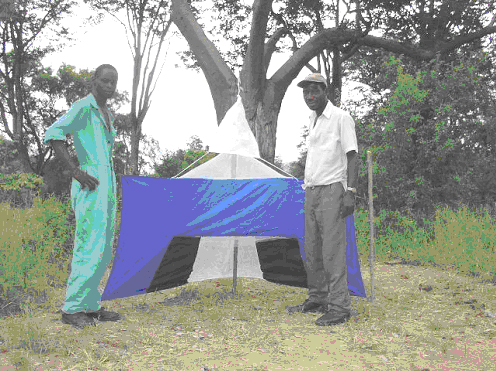
The Nzi trap is a simple, safe and economical cloth trap for the capture of biting flies (tsetse flies, horse flies, deer flies, stable flies). Superior design for trapping larger numbers and more types of biting flies. Flies are attracted to the color and shape of the trap. 6 ft wide, 4.5 ft tall, and 2 ft deep. Three poles required (not included). Use 1 trap per 20 acre pasture. Product code: FTNZI.
The cost per trap is $195.00 ($10.00 supports biting fly control research around the world).
• The Nzi traps horse flies, stable flies, deer flies, and yellow flies.
• Made in the US from durable marine grade canvas, high quality mosquito netting, and used plastic drink bottles.
• Three posts, not included, are required to set up the trap.
• One person can assemble in 4-10 minutes
• Simple, flexible set-up directions or more robust configurations for areas with stormy weather.
• No moving parts
• Only maintenance is removal of dead flies
• Requires no chemicals or baits
It was developed at ICIPE in Kenya as an environment-friendly alternative to the use of insecticides, following many years of research on appropriate and sustainable technology for African farmers. It is a passive killing device that works through the attraction of flies to large blue and black objects. Flies simply die from exposure after entering into an innovative configuration of cloth and netting.
Horse Pal Biting Fly Trap
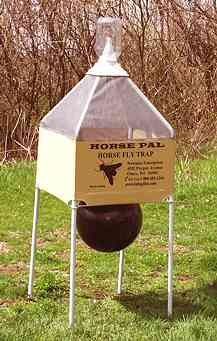 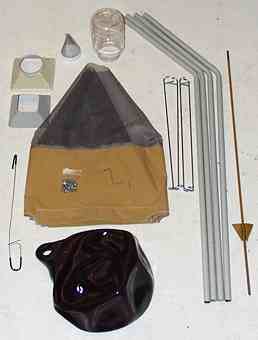
Size - 2 ft (0.61 m) square by 5 1/2 ft (1.68 m) tall.
Order directly from manufacturer: http://www.bitingflies.com/
The HORSE PAL® traps horse flies and deer flies ("greenheads"), and yellow flies.
Won't work with insecticides. Environmentally sound. Requires no chemicals or messy baits; just a no-maintenance target.
Reduces the possibility of fly-born diseases.
The HORSE PAL® is constructed from marine grade canvas, fiberglass screen, plastic coated steel legs, and other premium materials for many seasons use.
Shipped via UPS or U.S. mail in the USA and Canada
5/16 nut driver, 7/16 wrench, and bicycle tire pump required for assembly.
Only maintenance required is the occasional removal of dead flies.
Patented
http://www.bitingflies.com/
Other Devices
There are high tech traps like the Mosquito Magnet that may work well for you and fit your budget. These use heat, carbon dioxide and octanol to attract biting flies and then trap them.
DIY Traps
fly traps on the web
Biocontrol of Biting Flies
Chickens with cattle will pull appart the cow pats and eat maggots, making the cow pat less able to grow flies. Guinea fowl are the champions for moving soil and manure, but any chicken will do.
Dung beetles also distribute manure so that flies can't breed in them. We are working to network to distribute them
dung beetle monitoring info
Dung Beetle Field Day DVD
See also
Catalog of Fly Control in pdf
NZI Trap
|

